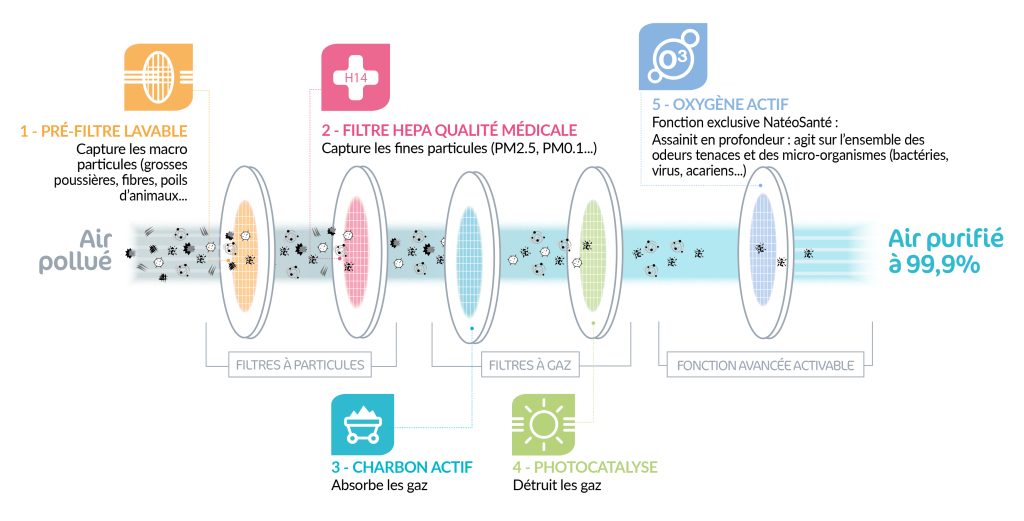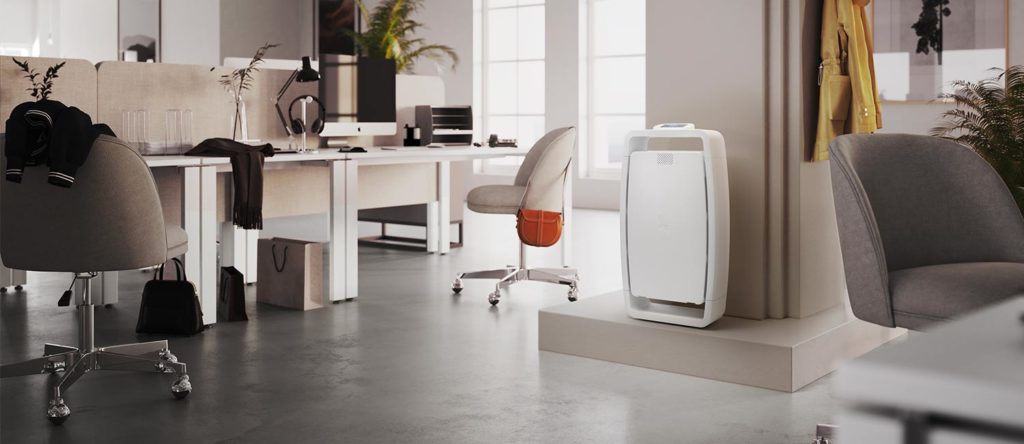21/11/2024


4 November 2023
The global Covid-19 epidemic, from the initial strain to the Delta and Omicron variants, has put air purifiers in the spotlight. NatéoSanté, a specialist in indoor air quality since 2009, has a long experience and hindsight on the evolution of these devices. Their primary function is to filter and purify the air. Since spring 2020, our EOLIS Air Manager models have been used to fight coronavirus, particularly in hospitals, schools and companies, and are at the cutting edge of innovation and technology. Within the framework of preventive health measures, they make it possible to complement aeration or ventilation with purification, while guaranteeing safety. A general presentation of these purification devices and a focus on the particularities of the brand.
Updated 01/12/2022 - Previous version 09/06/2021
An indoor air purifier ensures the filtration of the indoor air, of an enclosed space, which it captures to release a depolluted air. It works in addition to the necessary natural ventilation, if it is possible to open the windows.
A distinction must be made between a professional model and a domestic device, both of which do not guarantee the same air treatment and comparable overall performance levels.
A professional air purifier, equipped with a HEPA 13 or 14 filter, will have an effective action on pollens, fine particles PM2.5 and PM10, VOCs (Volatile Organic Compounds), viruses and bacteria.
Attention should also be paid to safety: that is, the ability of an air cleaner to generate no secondary pollutants itself.

This official position on air purifiers has changed since spring 2020. Previously, a negative opinion from the ANSES (The French Agency for Food, Environmental and Occupational Health & Safety) was the reference. In November 2020, a publication by the INRS (the French National Institute of Research and Safety for the Prevention of Accidents at Work and Occupational Diseases) and then in May 2021, a second contribution from the HCSP (the French High Council on Public Health) set the line: only equipment with a high efficiency filter against airborne particles is considered effective. Let us recall that in the case of Covid-19, they will play a role in the fight against possible transmission by aerosols, in addition to barrier gestures, wearing a mask... All the more so in closed places that do not allow airing. They can be coupled with a CO2 sensor which will act as a containment indicator and will warn the occupants of a place when the threshold limit of 0.08% is exceeded (see the HCSP recommendations on the subject).
Limit the spread of harmful residues or allergic or even viral elements, prevent asthma or allergy problems linked to poor indoor air quality in people at risk (children, elderly or sensitive people).
An air purifier, not to be confused with an air ioniser or an air humidifier, can be used in a preventive and/or curative way, at home, in closed offices, open spaces or coworking places, shops, hairdressing salons, hotels or restaurants, medical and para-medical practices... By extension, as a result of Covid-19, it is becoming increasingly important in schools, hospitals, the medical and paramedical sector, the tertiary sector, etc.
It concerns people or companies with no particular problems but who wish to protect their health, that of their entourage or employees, for example for the latter in a situation of resumption or continuity of the activity. The indoor air purifier is, in this sense, in phase with the current health and societal issues related to air quality. Both with regard to PM2.5 fine particle pollution and the risks associated with the propagation of viruses by air or aerosols.
See our professional air purifiers
The purifier filters the indoor air and purifies it, removing the various sources of pollution and pollutants.
This air purification goes through several steps. Firstly, the purifier sucks in the air in the room in order to retain the particles. The air is then passed through various filters that retain the different types of pollutants present in the air.
Depending on the performance of your air purifier, it will be able to treat different volumes of air associated with the size of your rooms (bedroom, living room, dining room), offices, common areas, open spaces, etc.
For optimal operation, it is essential to integrate one air purifier per room: we always talk in terms of partitioned areas.

The pre-filter captures macro-particles such as coarse dust, animal hair, etc. Placed directly between the front door and the other filters, it is the first filtration system, acting as soon as the air enters the appliance. This filter, which is generally washable, preserves the life of the other filters by filtering macro-particles upstream.
The HEPA filter of a professional air purifier like EOLIS Air Manager is able to retain more than 99% of particles larger than 0.3 µm. This filter is of medical quality. It is also called an absolute filter.
It is made of a very fine fibre layer. Thanks to its tight weave, it retains dust mites, pollen, mould, fungi, pesticides, bacteria, viruses, fine dust, animal hair and diesel particles.
The EOLIS Air Manager air purifier is 99.6% effective against coronavirus. This result was obtained and certified through tests conducted by an independent microbiology laboratory. They were published in November 2020 by NatéoSanté. They were carried out on a strain of human coronavirus (HCoV-229E) close to the SARS-CoV-2 strain responsible for the Covid-19 epidemic.
See test results and methodology
The activated carbon filter is mainly used to destroy bad smells present in a room. It is a filter containing activated carbon beads that filter and eliminate toxic gases like benzene, hydrogen sulphide, formaldehyde, ammonia vapours, bleach, bad smells, etc. Activated carbon filters, used by NatéoSanté in its air purifiers, also help to eliminate excessive ozone quantities in your air.
The polluting particles are absorbed through an oxidation and reduction reaction between the catalyst and the UV-C radiation. This process converts the VOCs into H2O and CO2. This function can be activated and deactivated on our models.
The active oxygen function treats the indoor air deeply. This function, to be activated when you are not present in the room or at your workplace, eliminates incrusted odours (sheets, textiles, carpets) and also treats the space against mites and mould. This feature is available as an option on the EOLIS Air Manager professional indoor air purifier. It can also be activated and deactivated on our various models.

Each air purifier has its own performances and technical characteristics. Before buying an air purifier, you should compare the filtration levels of the different devices and consider these criteria when purchasing your air purifier. The effectiveness of your product against domestic pollution depends on precisely how you use the device and which one you choose. Asthma, allergies, fine particles, odours, and more—for some, it is used as a preventive measure, for others it simply provides extra comfort by promising healthy and purified air. Here are the criteria you should consider when purchasing your air purifier:
The Three Ranges of NatéoSanté Air Purifiers: EOLIS Air Manager, Air Protect, and Hygeolis
The air purifier is intended for anyone (CEO, Head of Human Resources...) wishing to treat the air quality at their home or place of work. The air purifier can be used for both curative and preventive purposes. It is extremely useful for people suffering from respiratory diseases such as asthma or allergies, but also for people who want to eliminate pollution or bad smells.
Improve Indoor Air Quality with NATEOSANTE Professional Air Purifiers
Indoor air quality has become a major public health issue, both in domestic and professional environments. At NATEOSANTE, we understand the importance of breathing clean and healthy air, whether in offices, healthcare facilities, or industrial environments. Our professional air purifiers are designed to provide an effective air filtration solution, reducing risks associated with fine particles, allergens, and volatile organic compounds (VOCs).
Air Quality Control and Improvement: A Health Priority
In workplaces, the concentration of pollutants such as dust, VOCs, or mold can lead to serious health problems like respiratory diseases, infections, or allergies. Our air purification systems not only help control indoor air quality but also reduce the risks of diseases such as tuberculosis or airborne infections, which are often a concern in healthcare settings.
Thanks to advanced filtration technology, including HEPA filters and activated carbon filters, our purifiers capture up to 99.97% of airborne pollutants, including pathogens, viruses, and fine particles (PM2.5). This is especially crucial in environments where real-time air monitoring is vital, such as hospitals or facilities sensitive to contamination risks.
Filtration Solutions for Industrial and Professional Environments
Industrial environments, such as workshops or production sites, are often exposed to high levels of air pollution, including toxic substances and harmful gases such as carbon monoxide (CO) and carbon dioxide (CO2). At NATEOSANTE, we offer air filtration solutions for industrial environments that help protect employees from the risks posed by fine particles and volatile chemical compounds.
In addition to ensuring clean and healthy air, our professional air purifiers contribute to creating a pleasant and safe working environment, thereby reducing absenteeism caused by respiratory illnesses.
Air Purification and Decontamination in Healthcare Settings
Hospitals and other healthcare facilities are places where disinfection and environmental monitoring are essential to prevent the spread of infections. Our air purification systems integrate seamlessly into bio-cleaning and hospital disinfection processes. They effectively reduce the risks of virus, bacteria, and other pathogen transmission.
These solutions are particularly useful in managing infections related to viruses such as COVID-19 and monkeypox, as well as in combating agents like mpox.
High-Performance and Quiet Air Purification Systems
Acoustic comfort is also a key factor in work environments. Our air purifiers are designed to operate discreetly, even in spaces where silence is essential, such as offices or conference rooms. Their purification efficiency is coupled with low energy consumption, making them both eco-friendly and cost-effective solutions for all businesses.
Innovative Practices for Clean Air in the Workplace
At NATEOSANTE, we are committed to offering cutting-edge products in terms of decontamination procedures (an alternative to often cumbersome and lengthy sterilization procedures) and best practices for purifying indoor air. Our ventilation systems not only filter the air but also ensure that the strictest hygiene standards are met.
Whether you’re looking for an air purifier for a professional environment, a hospital, or a public space, our solutions are tailored to your specific needs. They provide an effective response to the challenges posed by indoor pollution and respiratory diseases, while creating healthier and safer workspaces.
Let me know if you’d like any further modifications or additional translations!
more information:
BUSINESSES: why buy a professional air purifier?